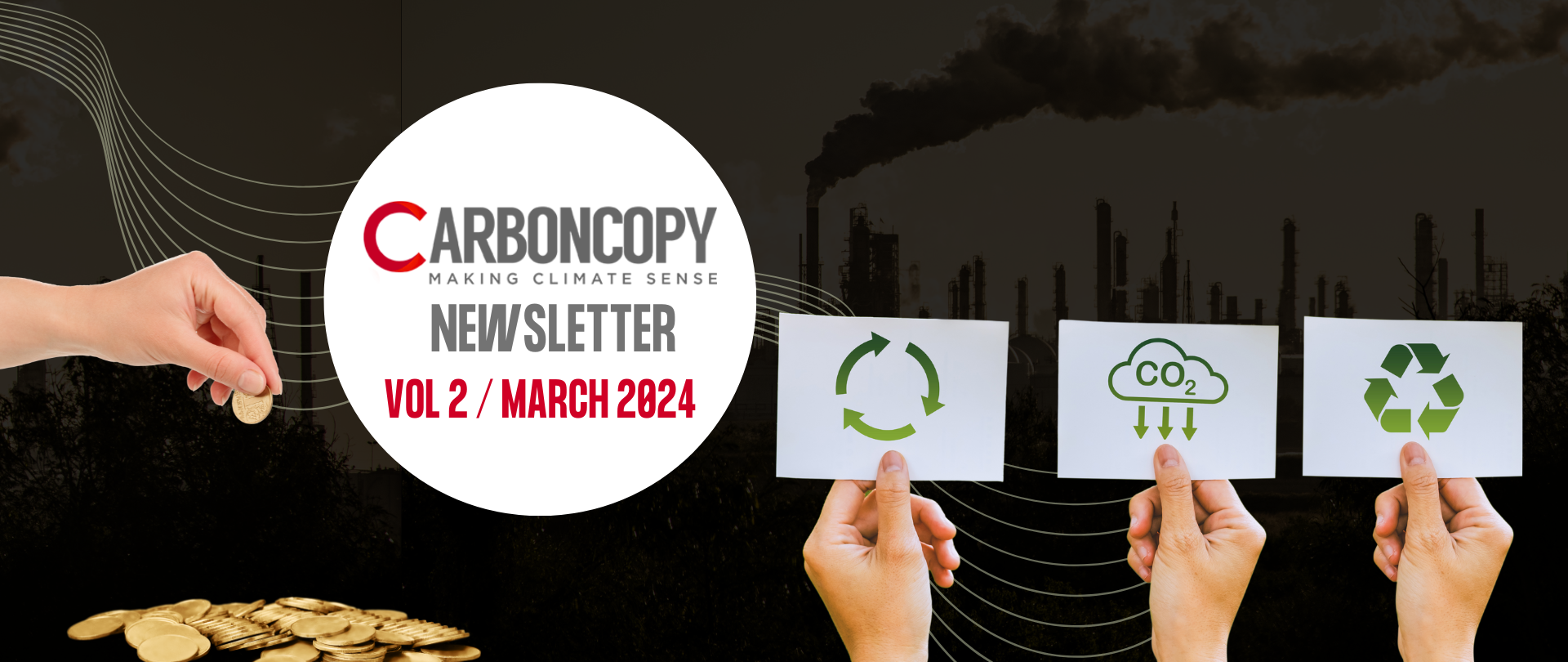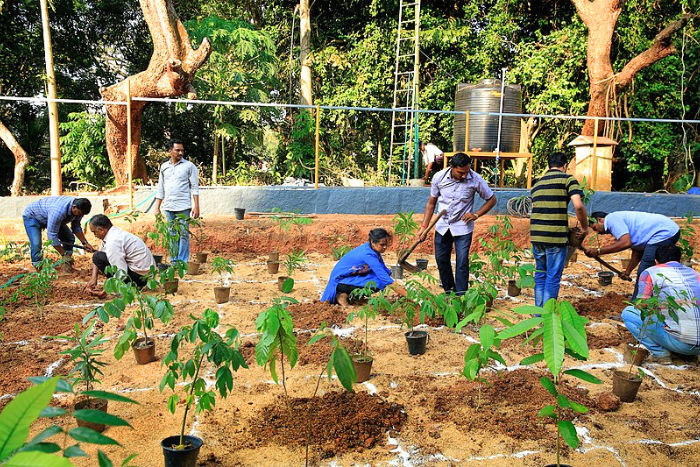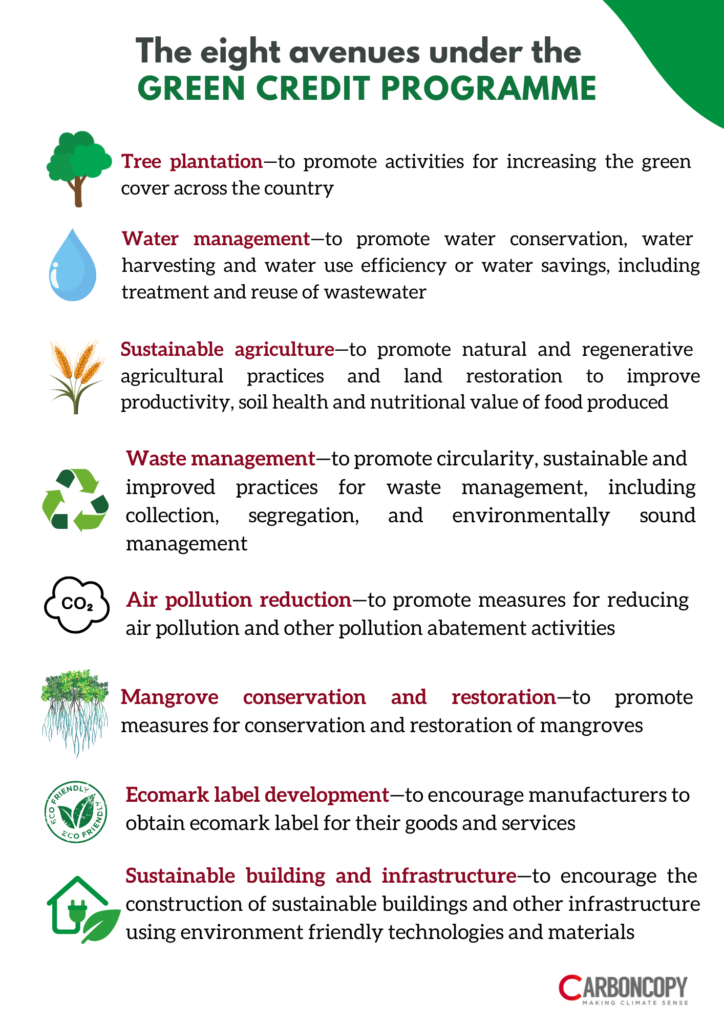


The final methodology for green credits for tree plantation activities seems to legitimise greenwashing, raising questions about the programme’s tangible environmental benefits. Read more
The Green Credit Programme (GCP) aims to generate tradable units that reflect positive environmental impacts of interventions and activities through any of eight identified avenues. Photo: BemanHerish/WikimediaCommons
India’s Green Credits programme: Choosing creative accounting over credibility?
The final methodology for green credits for tree plantation activities seems to legitimise greenwashing, raising questions about the programme’s tangible environmental benefits
India’s Green Credit Programme (GCP), currently under construction, saw its first discernible wall erected in February. The country’s environment ministry notified the final methodology for the issuance of green credits for the plantation of trees. The notification is the first significant development after Prime Minister Narendra Modi drew the spotlight on ‘Green Credits’ at the opening of the COP28 in Dubai as “a campaign that moves beyond the commercial mindset of carbon credit and creates a carbon sink with public participation.” This pitch was followed by the launch of an Global Green Credits Initiative along with UAE’s COP Presidency.
The rules for the governance of India’s GCP was notified in October 2023, weeks before Modi’s appearance at the COP in Dubai. Up front, the scheme is framed as “an innovative market-based mechanism to incentivise environment positive actions” among commercial entities and individuals. Envisioned as a voluntary market mechanism that runs in parallel to the Carbon Credit Trading Scheme (CCTS) (which will be based on compliance of emission reduction mandates for chosen industries), the GCP aims to generate tradable units that reflect positive environmental impacts of interventions and activities through any of eight identified avenues.

India has a $10.1 trillion funding gap to meet its net-zero by 2070 commitment. The Indian Carbon Market, which includes both green credits and carbon credits, expects to channel funds through the two market schemes to fund its net-zero goals. The GCP and the Carbon Credit Trading Scheme (CCTS) have another foundational difference that stems from how tradable units are defined. While the credibility of carbon credits relies on the coherence of the credit with a physical and quantifiable unit i.e. the amount of carbon emissions, green credits are governed by broader, more conceptual boundary conditions without a clear physical standard, and articulated simply as units that are provided for activities delivering a “positive impact on the environment.” What exactly this means is revealed only by the individual methodologies that are developed for each of the eight identified avenues for environmental sustainability interventions and activities—how credits will be generated and the basis on which they will be verified.
A green-tinted resource grab?
The first of these methodologies was finalised in late February 2024 for tree plantation activities, a little more than four months after the draft methodology was published for public feedback and comments.
Under the February notification, the central and state forest departments have been tasked with identifying and making available ‘degraded land parcels,’ at least 5 hectares in area, under their administrative jurisdiction and management, including open forest and scrub land, wasteland and catchment areas for tree plantation activities aimed at increasing India’s green cover. The Green Credits website so far lists 161 “approved” parcels of land across 9 states and the Union Territory of Daman and Diu accounting for 3,664 hectares.
The Indian Council of Forestry Research and Education (ICFRE), which has been denoted as the administrator for the Green Credit programme, will be in charge of receiving applications and proposals from entities willing to undertake tree plantation activity and allocating land from the parcels identified. Upon the payment of tree plantation and administrative costs, the forest department will carry out the tree plantation under direction from the ICFRE and in accordance with the work plan for the project. The timeline to undertake this activity has been set as two years from the date of payment. The methodology specifies that each tree planted under the scheme would generate one credit, subject to a minimum density of 1,100 trees per hectare. Issued credits can then be traded between entities and used to meet Corporate Social Responsibility (CSR) and Environmental, Social, and Governance (ESG) obligations of companies—from which demand for credits are expected to be generated.
Interestingly, the final rules reflect a massive departure from the draft methodology issued in October 2023. For one, the draft methodology had proposed a range between 100-1,000 trees per hectare along with an identification of species in line with agro-climatic and soil conditions. It also proposed a phased issuance of credits over a 10-year period following plantation in order to incorporate factors such as survival rate, tree growth and crown cover. Additionally, a multiplication factor in accordance with annual rainfall levels found a place in the draft. It is important to note that while survival rates of trees in plantations vary greatly from case to case, literature indicates an average survival rate of around 50% for public tree plantations. The choice of species, method of plantation and post-plantation care have been identified as strong influencing factors in the survival of species.
The final notification, however, does away with all details aimed at efficacy and credibility of the credits, and instead replaces it with one line stating the 1,100 tree limit “based on the local silvi-climatic and soil conditions.” Ostensibly, the hike in the target number to beyond the upper limit suggested in the draft is in lieu of the factors that reflect species suitability, tree survival and growth. Under the final framing, the activity of plantation by itself is eligible for credits, all of which can be granted upon verification. Notably, however, the final methodology remains conspicuously silent on how this verification will be done and who will be responsible for it—an aspect which had been fleshed out in relatively greater detail in the draft. These issues raise important questions around the real-world credibility and fungibility of these Green Credits.
Has the final methodology for green credits issued through tree plantation activities legitimised greenwashing, rather than provide any tangible environmental benefit?
This kind of credibility crisis is a symptom of the current Voluntary Carbon Markets regime with the efficacy of many projects and carbon credits coming under question in media and research. This has led to a steep fall in liquidity and confidence in the VCM, with many buyers reducing their activity. According to S&P the Platts Nature-Based Avoidance price, which reflects the most competitive internationally fungible carbon credits issued by nature-based projects such as REDD+ projects, continues to languish at record lows. The Platts-assessed nature avoidance prices plummeted to just over US$3/ tonne of CO2 at the end of January 2024, 81% lower than the high prices of over US$11.50/tonne of CO2 seen a year ago in January 2023.
Interestingly, the tree plantations will also be eligible for the generation of carbon credits, which can be traded through the parallel CCTS, but through a separate process of assessment, monitoring and evaluation that would be overseen by the CCTS governing structure.
The compensatory mis-direction
An additional layer of complexity comes from the explicit provision for the usage of Green Credits for compliance with the compensatory afforestation rules under the Forest (Conservation) Act/ Van (Sanrakshan Evam Samvardhan) Adhiniyam, 1980, which mandates project developers to replace trees cut down on forest lands through plantations raised on alternate sites. A significant change in these in the rules for compensatory afforestation in 2022 allowed companies required to carry out compensatory afforestation to simply buy up existing privately owned plantations rather than setting up fresh plantations, implicitly diluting the effectiveness of the motive to replace lost forest cover. Eligible plantations, however, had to be at least five years old, spread across at least 10 hectares and have a canopy density of at least 40% The GCP now goes one step further by eliminating these conditions and opening up the possibility of meeting compensatory afforestation requirements through the purchase of green credits.
A letter signed by 91 former civil servants in the weeks after the methodology was notified raised strong objections to the rationale of this provision. “No amount of money can be a substitute for the land required for our forests, and for our biodiversity and wildlife to thrive. Yet, the government is trying to make it easy for entrepreneurs and industrialists to acquire forest land by permitting them to offer, in exchange, money (in the form of green credits), instead of land for land as was the case so far. When forest land can be so easily obtained by private entrepreneurs, it does not take much imagination to realise that the extent of land legally classified as forests at present will steadily shrink until there is virtually nothing left. A new set of Green Credit invaders may ask for diversion of some of our densest and best protected forests for commercial purposes like mining, industry and infrastructure,” the letter reads.
Researchers suggest that market-based mechanisms in India need to give importance to biodiversity values and ecosystem service provisioning to benefit local communities democratically. They say the Indian landscape has reported that efforts to conserve, increase or protect forests may be misdirected, for example in choosing the wrong tree species for reforestation. The study recommends that projects selling credits must inform investment decisions. If the focus is restricted to only carbon sequestration, there is a higher likelihood of developing near-monocultures of fast-growing tree species. Not only the carbon market quality would be negatively affected by such activity, but it will also lead to an ensuing disturbance of the entire landscape, both from ecological and socio-economic perspectives, the study concludes.
A blind numbers chase
While tree plantations remain the only activity for which a GCP methodology has been finalised, a draft methodology for the issuance of Water Harvesting based Green Credits was also published in October 2023. Water harvesting activities covered under the scheme, as per the draft, have been reduced to conservation structures such as earthen ponds and poly tanks—with 100 cu.m of capacity eligible to generate 75 credits. Meanwhile, other interventions that increase water-use efficiency, groundwater recharge and other in-situ conservation techniques have been left out of the draft.
Similar to the draft on Tree Plantations, credits for water conservation projects have been proposed in a phased manner over 10 years following the completion of construction. Unlike the Tree Plantations draft though, 60% of the credits have been proposed to be issued in the first year immediately following construction. Multiplication factors in accordance with the annual average rainfall levels have also been included in the draft to encourage the undertaking of projects in rain-deficit regions. If the final methodology for tree plantations is anything to go by, one would expect much of this qualitative nuance to be left out of the final version in favour of heightened focus on quantitative targets—a rationale that echoes the target of digging 2 million farm ponds that the NDA government had issued in its first term and the success of which was dubious in terms of utility and longevity of the harvesting structures that were constructed.
The Indian government’s apparent fixation with high number targets must be seen in the context of the country’s commitments on climate and environment. India’s Nationally Determined Contributions (NDC) toward the UN Framework Convention on Climate Change (UNFCCC) and the Paris Agreement includes the creation of an additional carbon sink of 2.5 to 3 billion tonnes of CO2 equivalent through forest and tree cover by 2030. Incidentally, this remains the NDC target that has seen the least progress so far. India is also a signatory to the UN Convention on Biodiversity (UNCBD) Kunming-Montreal Global Biodiversity Framework (GBF) of 2022, which entails targets to conserve 30% of degraded ecosystems and 30% of of terrestrial and inland water areas, and of marine and coastal areas, by 2030. Under the UN Convention to Combat Desertification (UNCCD), the Indian government updated its 2030 target to restore degraded lands to 26 million hectares in 2019.
When seen in this context, the significance of the GCP as a centrepiece of India’s contemporary environmental policy becomes clearer. What also becomes clearer is an overarching strategy of relying on indirect quantitative indicators such as number of trees or water conservation structures rather than more direct qualitative indicators of the impact delivered by interventions in order to meet these commitments. This strategy may be easier to frame narratives around. They, however, also carry a significant risk of dissonance between intention and outcome of investments—a central tenet in maintaining the integrity of markets.
Another aspect that comes to the fore is the progressive shifting of environmental and climate responsibilities away from public institutions such as forest departments and toward private investors. While this is in line with a broader international recognition that sources of finance for climate and environmental action must include private sources, complete abandonment of qualitative standards to accelerate this shift has perilous potential that includes not only economic implications of poor credibility, but also risks of larger ecological deterioration. In framing the GCP rules and methodologies, the Indian government faces a choice between creative accounting and credibility. Failure to prioritise the latter—thereby opening the door for greenwashing—as is evident in the final methodology for Green Credits issuance through tree plantations, will amount to little more than a discounted transfer of natural wealth into private hands in a way that almost entirely cuts out the public and its interests from the deal.
The most heatwave-prone areas are Gujarat, Madhya Pradesh, Maharashtra and north Karnataka followed by Rajasthan, Madhya Pradesh, north Chhattisgarh, Odisha and Andhra Pradesh.
Expect more than double the number of heatwaves this summer: IMD
The India Meteorological Department (IMD) warned that most of India will face “extreme heat” between April and June and more than double the number of heatwave days than is usually seen at this time of the year, HT reported.
The outlet added that around 10 to 20 days of heat waves are expected in various parts of the country against the usual four to eight days seen in a usual year. The most heatwave-prone areas are Gujarat, Madhya Pradesh, Maharashtra and north Karnataka followed by Rajasthan, Madhya Pradesh, north Chhattisgarh, Odisha and Andhra Pradesh, IMD said in its outlook.
Experts attributed the higher likelihood of heatwaves and the hotter summer in general to the El Nino phenomenon (warming of the equatorial Pacific Ocean, which in turns leads to a cascading effect across the world). This year’s El Nino is one of the five strongest-ever recorded. El Nino is a naturally occurring climate pattern associated with warming of the ocean surface in the central and eastern tropical Pacific Ocean. It influences weather and storm patterns in different parts of the world. But it takes place in the context of a climate being changed by human activities,” the WMO said earlier this month.
Other experts attributed the record-breaking heat globally last year to the climate crisis; heat-trapping greenhouse gases are unequivocally the main culprit.
Heat, aridity, clear skies: Why forests are already ablaze in the Nilgiris
In South India, most forest-covered areas of Andhra Pradesh, Karnataka and Tamil Nadu have seen fire incidents in March. For almost a week, forest fires were raging in the Coonoor forest range in the Nilgiris in Tamil Nadu. The Indian Air Force joined the ongoing firefighting efforts of the state forest department, deploying an Mi-17 V5 helicopter to conduct multiple “Bambi Bucket” operations that dumped some 16,000 litres of water on the fires.
November to June is considered forest fire season in India. The biennial India State of Forest Report (ISFR) published by the Forest Survey of India (FSI) under the Ministry of Environment, Forest and Climate Change recorded in its 2019 report that more than 36% of India’s forest cover was prone to frequent fires. About 4% of the forest cover was ‘extremely prone’ to fire, and another 6% was ‘very highly’ fire prone (ISFR 2019).
Crowded and warmer: Unequal dengue risk at high spatial resolution across a megacity of India
According to a new study, the poorest and most crowded neighbourhoods of Delhi could face the largest increases in dengue fever transmission risks as temperatures increase. The research examines how both temperature and human population density, which affects the breeding rate of dengue-carrying mosquitoes, could impact disease transmission in the megacity, reported the web portal Journals. The researchers made a highly detailed map of dengue disease risk in Delhi, at a resolution of 250m by 250m. The researchers say: “Results underscore the inequity of risk across a complex urban landscape, whereby individuals in dense poor neighbourhoods face the compounded effect of higher temperatures and mosquito carrying capacity.”
Ladakh wants to prevent what happened in Himachal Pradesh, Uttarakhand & Sikkim: Sonam Wangchuk
To protect the ecologically fragile Himalayan region, environmentalist Sonam Wangchuk went on a 21-day fast demanding the implementation of the Indian Constitution’s Sixth Schedule and statehood for the Union Territory (UT) of Ladakh. He said his movement wants to prevent tragedies (such as land subsidence) similar to those that have occurred across Himalayan regions like Himachal Pradesh, Uttarakhand and Sikkim over the past few decades.
Himalayan tragedies in Ladakh, Himachal and Joshimath have been blamed on projects extracting natural resources in the region. Himachal saw huge destruction last year. People died and property worth crores destroyed, according to reports. Activists blamed it on projects promoting tourism, hydel power and four-lane highways, reported Down to Earth. Wangchuk and other environmentalists called for setting up ‘People’s Commission for Himalayas’.
Record heat index of 62.3°C scorches Brazil’s Rio de Janeiro, Kuwait braces for ‘unliveable’ summers
Rio de Janeiro’s is battling “stifling” heat wave as heat index hit 62.3°C (144.1°F), the highest in a decade. The heat index measures what a temperature feels like by taking into account humidity, AlJazeera reported. The actual maximum temperature in the city was 42°C on Monday. The last time heat index record was set in November at 59.7°C (139.5F). The southern region of the country was hit by extreme rains that are forecast to continue next week, according to authorities, the news outlet said.
Meanwhile, the Kuwaiti government issued an edict allowing funerals to be conducted at night. Expecting very high summer temperatures (the city regularly breaches 52°C during summers), Mirror reported adding that Kuwaitis rarely venture outdoors during summer, but migrant workers bear the brunt outdoors. There is now an entire indoor shopping street, lined with palm trees and European-style boutiques, the report said. Climate scientists are predicting that temperatures will be up 5.5C by the end of the century. Annual rainfall has been dropping in the already arid country, the frequency and intensity of dust storms increasing as a result, the report said.
Humid heat waves in southern West Africa made 10 times more likely by climate change: Study
New research conducted in West Africa says humid heatwaves usually occur in March or April, but they arrived in February 2024. The humid heatwaves in southern West Africa in February, would have been ‘impossible’ without human-induced climate change, according to an analysis by the international team of leading climate scientists from the World Weather Attribution group, released March 22, 2024.
The researchers found that climate change made the heatwave as measured by the heat index about 4°C hotter. While the average air temperature in West Africa was above 36°C, the heat index for the same period was about 50°C. The combination of humidity and high temperatures caused dangerous conditions. The heat index even entered the level of ‘extreme danger’ that is associated with high risk of heat stroke, with values up to 60°C, said the analysis which involved scientists from Nigeria, Burkina Faso, Switzerland, Sweden, South Africa, the Netherlands, Germany, the United Kingdom and the United States.
A warming climate will make Australian soil a net emitter of atmospheric CO2
As global temperatures rise, Australia will become hotter and drier and its soils will become a net emitter of CO2, according to new research. Studying the changes in Australia’s soil organic carbon stock from 2010 to 2100, the research shows losses of 0.014-0.077 tonnes of carbon per hectare per year over 2020-45 and 0.013-0.047 tonnes for 2070-2100, under increasing emissions of greenhouse gases and temperature. These predicted net losses of soil carbon will “significantly affect Australia’s ability to achieve its greenhouse gas (GHG) emissions reduction target”, the authors said. They added that to shift to a more sustainable pathway, Australia “must embrace existing GHG removal technologies and develop new large-scale solutions to achieve sustainability”, reported the study published in NPJ Climate and Atmospheric Science.
The lithium block in Jammu and Kashmir got less than three bids, which led to them being put up for auction in the third tranche.
Critical mineral auctions face set back, almost no takers for 7 blocks under hammer
Most of the first tranche of auction of seven critical mineral blocks had no takers. A second round is underway. These blocks will again be put up for the auctions in the fourth tranche after elections. Some rules have been tweaked, including putting in place clearances that were missing earlier and were proving to be a hindrance to the auction process, Hindu Businessline reported. The lithium block in Jammu and Kashmir got less than three bids, which led to them being put up for auction in the third tranche. The third tranche bidding ends in May and covers six other critical mineral blocks namely glauconite, graphite, nickel, platinum group of element (PGE), potash and titanium, apart from lithium. These blocks are located in the states of Bihar, Jharkhand, Tamil Nadu, UP and J&K.
The Centre initiated the auction of 38 critical & strategic minerals to date. The initial tranche included 20 blocks, while the subsequent tranche consisted of 18 blocks.
India in undersea race to mine world’s battery metal, applies for 2 more licenses
The 29th session of International Seabed Authority (ISA) meeting took place in Jamaica, where governments gathered to decide the future of deep sea mining, amid growing public resistance, Campaigners said deep sea mining companies are pressing governments to agree on a mining code that would legitimise this destructive practice. India, which already has two deep-sea exploration licenses in the Indian Ocean, has applied for two more amid increasing competition between major global powers to secure critical minerals, reported BBC.
China, Russia and India seek to mine cobalt, nickel, copper, manganese, thousands of metres below the surface of oceans, to produce renewable energy such as solar and wind power, electric vehicles and battery technology needed to battle against climate change. The UN-affiliated International Seabed Authority (ISA) has issued 31 exploration licences so far, of which 30 are active. Its member countries are meeting in Jamaica this week to discuss regulations around giving out mining licences. If the ISA approves India’s new applications, its licence count will be equal to that of Russia and one less than China.
Around two dozen countries—including the UK, Germany, Brazil and Canada—are also demanding either a halt or a temporary pause on deep-sea mining, given what they say is a lack of information about the marine ecosystems in those depths.
COP28 President unveils shared vision of COP Presidencies Troika at Copenhagen Climate Ministerial
The Copenhagen Climate Ministerial took place last month where COP28 president Sultan bin Ahmed Al Jaber released a shared vision of a first-of-its-kind COP Presidencies Troika. The Troika said the next round of Nationally Determined Contributions (NDCs) should be in line with keeping 1.5°C within reach. The Troika was agreed in the historic UAE Consensus and aims to enhance continuity between COP28, COP29 and COP30 and drive implementation of the UAE Consensus.
“Parties must do the work now to ensure that their NDCs meet the urgency of the moment—and are submitted at least nine months before COP30,” Jaber said adding that NDCs should cover all greenhouse gases—including methane. He also said the countries should put policies in place to deliver emission reductions of 60% compared to 2019 levels, before 2035. Jaber called for attendees to “follow the science” and ensure energy transition pathways are “just, orderly and responsible”.
UN’s climate body faces “severe financial challenges” which put work at risk
UNFCCC chief Simon Stiell made an urgent plea for government donations to bridge the UN body’s funding gap. The UNFCCC is facing “severe financial challenges” as the ability to fulfil its expanding workload is being put at risk by governments’ failure to provide enough money.
Stiell made an urgent plea for more funding to over 40 ministers and negotiators gathered on Thursday in Helsingør, Denmark, for the first major climate summit of the year. “We are attempting to meet an ever-growing mandate. Our job is to make your job easier. To carry out the tasks you have all agreed we should do, but we can only do this if we have the funding support.” Stiell said the organisation’s budget “is currently less than half funded”.
EU nature restoration laws face collapse, member states withdraw support
The EU’s nature restoration laws, which were due to be rubber-stamped in a vote by member states, now “appear on the verge of collapse”, The Guardian reported. The laws “have been two years in the making and are designed to reverse decades of damage to wildlife on land and in waterways”. However, the vote was shelved after it “became apparent the legislation would not pass its final stage with the majority required”. The European environment commissioner warned that shelving the bill indefinitely would destroy the EU’s reputation globally given it had led the way at the COP15 biodiversity summit in Montreal in 2022.
The news portal said the setback is the biggest blow to the EU’s environmental agenda in recent months, as policymakers decide how to respond to farmers’ protests across the bloc. As the demonstrations continue—in advance of the June [European Parliament] elections—many green rules have been weakened.”
The stations will monitor PM2.5 and PM10 concentrations, as well as levels of carbon monoxide, sulphur dioxide, nitrogen oxides, ammonia and ozone. Photo: Air pollution monitoring station sensors by brewbooks/Wikimedia Commons
Maharashtra to install 50 continuous ambient air quality monitoring stations
The Maharashtra Pollution Control Board (MPCB) invited bids to set up 50 Continuous Ambient Air Quality Monitoring Stations (CAAQMS) in 36 different locations. in the state, including Thane, Ulhasnagar, Nanded, Beed, Gondia, Nandurbar, Satara, Hingoli, Buldhana, Bhandara, Gadchiroli, Ratnagiri and Sindhudurg. The municipal corporations of Thane, Vasai-Virar and Kalyan-Dombivali will get three monitoring stations each, the report said.
The stations will monitor PM2.5 and PM10 concentrations, as well as levels of carbon monoxide, sulphur dioxide, nitrogen oxides, ammonia and ozone. They will also measure wind direction, wind speed, ambient temperature, relative humidity, solar radiation and rainfall. The selected bidder will be responsible for operations and maintenance of the stations for a period of five years, with a possibility of a further three-year extension. The bidder will have to maintain a data display system showing the air quality index and share the data with the MPCB and the Central Pollution Control Board (CPCB) on a daily basis.
Air pollution causes anxiety, Delhi health department confirms NGT’s suo motu query
In a reply to green court (NGT: national green tribunal), the Delhi health department said while air pollution impacts mental health, causing anxiety and other problems, more India-centric studies were needed.
The tribunal had asked suo motu on the matter based on the TOI news titled “Feeling anxious? Toxic air could be to blame.” The Delhi government quoted several studies stating how adversely pollution impacts mental health. It sought more India-oriented research, TOI reported.
The Delhi government told the green court: “In India, where rapid industrialisation and urbanisation have led to increased pollution, understanding mental health implications is particularly crucial…. Exposure to various (types of) environmental pollution, including air pollutants, heavy metals, and noise pollution, is associated with an increase in mental health disorders, such as anxiety, mood, and psychotic syndrome, with both direct biological effects and stress related impacts.”
Fossil fuel industry biggest source of air-pollution-related diseases in Africa: Study
Egypt, Nigeria, and South Africa have emerged as Africa’s most polluted countries in terms of air pollution-related diseases, and the fossil fuel industry is the top source of pollution, a report prepared by Greenpeace Africa and Greenpeace MENA revealed.
Around 1.1 million premature deaths have been linked to air pollution annually in Africa.
Researcher Dr Aidan Farrow said data from satellites and even fuel sales in each country allowed scientists to investigate emission sources. Areas like Mpumalanga in South Africa, where coal burning for electricity is a major industry, really stand out.
Key findings compiled by the report include—air pollution is the second-leading risk factor for death in Africa. Egypt, Nigeria, and South Africa consistently exhibit large disease burdens, with the highest mortality linked to fossil fuel air pollution in these nations.
Six of the world’s 10 largest NO2 emission hotspots identified were found in Africa—all in South Africa. Two of the world’s 10 largest SO2 emission hotspots identified are in South Africa. Of the ten largest SO2 point sources identified in Africa, nine are thermal power stations. Four of the power plants are located in South Africa owned by Eskom, two in Morocco and Egypt, and one in Zimbabwe.
World produced 62 billion kg e-waste in 2022, will rise to 82 billion kg by 2030: UN
According to a new study, the industry produced 62 billion kg of electronic waste (e-waste) in 2022, which may rise to 82 billion kg in 2030. “Solution for all e-waste issues is still not to generate any e-waste in the first place,” the Global E-waste Monitor 2024, study backed by the UN Institute for Training and Research (UNITAR), International Telecommunication Union (ITU), and Fondation Carmignac, a corporate foundation, stated.
Of this 62 billion, 13.8 billion kg is documented as ‘formally collected and recycled in an environmentally sound manner’, according to the UN report. Around 16 billion kg is estimated to be collected and recycled outside of formal systems in high- and upper-middle-income countries with developed e-waste management infrastructure. Around 18 billion kg is handled mostly by the informal sector in low- and lower-middle-income countries, with no developed e-waste management infrastructure.
The remaining 14 billion kg is likely disposed of as residual waste, the majority of which is put in landfills worldwide. The 62 billion kg of e-waste contained 31 billion kg of metals, 17 billion kg of plastics and 14 billion kg of other materials (minerals, glass, composite materials, etc.).
A whopping 58,000 kg of mercury and 45 million kg of plastics containing brominated flame retardants are released into the environment every year. Asia generates almost half of the world’s e-waste (30 billion kg), Europe (17.6 billion kg), Oceania (16.1 billion kg) and the Americas (14.1 billion kg) generated the highest amount of e-waste per capita in 2022.
Washing rice with arsenic-contaminated water poses a health risk?
Rice has more arsenic than other grains; washing or boiling it with arsenic-contaminated water poses significant health risks, according to a study conducted by the Institute for Sustainable Food at the University of Sheffield. The study found countries that do not adhere to the current World Health Organisation (WHO) recommended limits on the levels of arsenic in water are putting around 32% of the global population—particularly those from low and middle-income countries—at risk of serious health issues.
Many countries worldwide still use the outdated WHO limit (50 µg L-1 or parts per billion) for inorganic arsenic in water introduced in 1963, including several Asian countries such as China, Bangladesh, Pakistan, Cambodia, Thailand, Myanmar, and Nepal, where rice is the main staple food, the study said. According to Indian research, arsenic pollution has also entered the India water table.
Long-term exposure to arsenic in water used for drinking, food preparation or irrigation of crops can cause a range of health issues affecting every organ in the body, such as cancer, diabetes and pulmonary and cardiovascular diseases.
In the PIL, the petitioners urged that the Great Indian Bustard is a “critically endangered” bird, so to aid its conservation efforts, the cable line should be underground and not overhead.
India’s top court lifts ban on RE projects in endangered Great Indian Bustard territory
The Supreme Court of India lifted its 2021 ban and opened some 80,000 square km habitation of endangered Great Indian Bustard (GIB) in Rajasthan and Gujarat for energy companies (including NTPC, Adani Green, ACME, ReNew ) to set up 60 gigawatt (gw) of renewable capacity. The court relaxed its earlier order of mandatory underground cabling for solar energy projects. In April 2021, it had told the governments of Gujarat and Rajasthan that power transmission lines for projects should be underground. The priority area for GIB is 13,000 sq km in Rajasthan and 477 sq km in Gujarat. The potential area for green energy use is 78,500 sq km in Rajasthan and 2,108 sq km in Gujarat. In the PIL, the petitioners urged that the GIB is a “critically endangered” bird, so to aid its conservation efforts, the line should be underground and not overhead. As the GIB is partially blind and a low flying bird, it gets stuck in transmission lines and perishes. In 2021, the Centre, Rajasthan government and stakeholders in the solar and wind energy industry moved the Supreme Court and asked it to relax its order on power projects in the GIB habitats. The court said this week the cost of burning coal is higher than allowing overground transmission lines for green energy projects.
India’s total solar module manufacturing capacity reached 64.5 GW in 2023
India added 20.8 GW of solar modules and 3.2 GW of solar cell capacity in 2023. The country’s cumulative solar module manufacturing capacity reached 64.5 GW, and solar cell manufacturing capacity reached 5.8 GW as of December 2023. Of the installed module manufacturing capacity, about 60% was equipped to make modules in M10 and G12 wafer sizes, Mercom reported. The installed module manufacturing capacity in the country is 64.5 GW, the cumulative ALMM enlisted manufacturing capacity has reached 37.4 GW. This suggests that a large part of the installed capacity cannot be supplied to projects that are mandated to use the modules listed under ALMM.
As of December 2023, Gujarat was the frontrunner in India’s photovoltaic (PV) manufacturing landscape, commanding 46.1% of solar module production capacity. Rajasthan and Tamil Nadu came in at second and third positions for module manufacturing capacities, accounting for 9.3% and 7.6%, respectively.
Telangana is home to 39% of the annual solar cell production capacity, the highest in the country as of December 2023. Gujarat and Himachal Pradesh closely followed, with 34.7% and 13.9% of total capacities installed in the country.
Adani build solar, wind energy plant five times the size of Paris
Five times the size of Paris and visible from spac— that’s the size of Khavada, the sprawling solar and wind power plant in Gujarat that Adanis are building at a cost of about $20 billion. It will be the world’s biggest renewable park when it is finished in about five years, and should generate enough clean electricity to power 16 million Indian homes.
The success of the Khavda Renewable Energy Park is critical to India’s efforts to reduce pollution and hit its climate goals while meeting the burgeoning energy needs of the world’s most populous nation and fastest-growing major economy. Coal still accounts for 70% of the electricity India generates.
“A region so large, a region that is so unencumbered, there’s no wildlife, there’s no vegetation, there’s no habitation. There is no better alternative use of that land,” said Sagar Adani. It plans to invest $100 billion into energy transition over the next decade, with 70% of the investments ear-marked for clean energy.
India, Bhutan explore setting up of new hydropower projects
India and Bhutan will develop new energy projects in the fields of hydropower, solar and green hydrogen, with the participation of Indian entities as strategic partners.
India imposed ₹2,448 crore worth electricity from Bhutan in 2022, as per the Government of Bhutan’s data. The 1,020 MW Punatsangchhu-II hydropower project is expected to be commissioned this year, ET reported.
MNRE allows solar mini grid installations for tribal habitations
The government amended the guidelines for the implementation of the solar power programme for particularly vulnerable tribal group (PVTG) habitations/villages under the Prime Minister’s Jan Shakti Nidhi (PM JANMAN) initiative, reported Mercom. The government had approved the ₹5.15 billion (~$61.9 million) programme to build solar mini-grids for PVTG communities.
Previously, the programme focused solely on providing solar home lighting systems (SHLS) to individual households within PVTG habitations, the Mercom report said, adding that now the norms allow installing solar mini-grids to electrify clusters of households.
A solar mini-grid comprising components such as battery banks, distribution lines, metering, and control equipment can now be deployed instead of individual SHLS installations.
Each unelectrified household covered under the mini-grid will receive financial support of up to ₹50,000 (~$600) from MNRE.
Previously, only the Renewable Energy Service Company (RESCO) mode was specified for installing mini-grids, with MNRE providing financial support capped at ₹50,000 (~$600) per household, the report said.
Now the new norms allow both Capital Expenditure (CAPEX) and RESCO modes for mini-grid deployment. The Centre recently also approved the PM-Surya Ghar: Muft Bijli Yojana, with a budget of ₹750.21 billion (~$9 billion) as financial assistance for residential houses, group housing societies, and residential welfare associations.
The survey revealed that roughly 21% of participants indicated that there were "not enough electric car charging stations in my area/city/town."
Survey finds that only 5% may buy EVs this year
According to a survey, only 5 % of those looking to buy a four-wheeler in the country are likely to buy an electric car this year, reported Economic Times. Of the 40,000 participants in the poll, which was done over a three-month period, 42% are from tier-1 cities, 34% are from tier-2 cities, and 24% are from tier-3, tier-4, and rural areas. According to the report, about 7% of participants in the poll stated there were “not enough choices of models within budget,” while 21% said e-cars were “more expensive as compared to regular cars.” The survey revealed that roughly 21% of participants indicated that there were “not enough electric car charging stations in my area/city/town,” and 12% stated that they “don’t know enough about these vehicles,” which may account for the comparatively low interest in e-four-wheelers.
Maharashtra calls for bids to set up 350 EV charging stations
The Mahatma Phule Renewable Energy and Infrastructure Technology (MAHAPREIT) —the subsidiary of Mahatma Phule Backward Class Development Corporation’s (MPBCDCL)— is seeking bids from potential empanelment agencies to establish 350 electric vehicle (EV) charging stations around Maharashtra.
The job encompasses the installation of 350 charging stations, maintenance and operation tasks, and end-user charging services. Additionally, electricity costs will be borne by the bidders. Along with meeting additional financial eligibility requirements, bidders must have installed a minimum of 10 public EV charging stations in the last five years. Recipients of the MPBCDC or any newly established Scheduled Caste unit must present authentic credentials of caste, domicile, and incorporation. The winning bidder will need to set aside 100 square feet at the site so that future installations of battery swapping stations can be made.
Nickel farming, the use plants to extract nickel from soil, may become reality
The US Department of Energy is spending $10 million to investigate the possibility of farming nickel, which is required for lithium-ion batteries. Plants are being used by researchers to remove nickel from soil. Scientists have discovered hyperaccumulators—plants that grow well in nickel-rich settings and absorb battery metals—in Malaysia. As much as 3.3% nickel and 4.6% manganese can be found in the leaves of the Antidesma montis-silam tree, which grows quickly on the island of Borneo. These metal concentrations are significantly higher in the sap.
Scientists are looking into the possibility of using a hybrid farming and mining technique called phytomining to harvest metals such as nickel, manganese, and other elements that hyperaccumulators collect from the soil.
Ministry of Power releases guidelines for viability gap funding for battery storage
Mercom reported that the operating rules for the ₹94 billion (~$1.1 billion) programme, which offers viability gap finance (VGF) of up to 40% to create 4,000 MWh of battery energy storage systems (BESS) capacity nationwide, have been released by the Ministry of Power (MoP). The funding was announced during the 2024 interim budget in February this year.
The programme will receive ₹37.6 billion ($452 million) in funding and run for three years, from 2023–2025. According to the programme requirements, projects must be completed 24 months from the date of agreement. Five tranches of funds, each corresponding to a milestone such as financial closure and commercial activities, will be distributed. In accordance with MoP norms, the tariff-based competitive bidding process will be used to award projects. In order to compete, developers will submit quotes that are the lowest annualised fixed costs, subject to tariff limits decided by a committee.
NATO launches business accelerator to invest 1 billion Euros in climate tech startups
The North Atlantic Treaty Organization (NATO), the military alliance, launched its first business accelerator programme mainly for climate technology startups, under its NATO Investment Fund. NATO’s entry into venture capital is marked by the new programme, the Defence Innovation Accelerator for the North Atlantic, or DIANA, which is focusing on solving security issues related to climate change.
DIANA was established in 2023 with a fund of € 1 billion, sourced from NATO member nations. Its objective is to finance technological advancements that augment energy resilience and tackle security risks intensified by climate change.
The primary areas for startups admitted into DIANA’s programme include energy resilience, cybersecurity, and surveillance, with a particular emphasis on renewable energy solutions. These firms are able to access specialised testing facilities and resources in addition to receiving initial grants. However, given the military context of NATO, some investors have hesitation regarding the potential ethical and financial implications.
China challenges USA’s “discriminatory” EV subsidies at WTO
To protect its interests in the electric vehicle sector, China has started dispute settlement procedures against the United States at the World Trade Organisation (WTO), reported Retuers. According to China, the country is challenging the “discriminatory subsidies” under the USA’s Inflation Reduction Act (IRA), which is leading to the exclusion of goods from China and other WTO nations.
A statement from the China’s Ministry of Commerce said that “Under the pretext of ‘responding to climate change’ and ‘environmental protection’, the US has formulated discriminatory policies through its Inflation Reduction Act regarding new energy vehicles, excluding products from China and other WTO members from subsidies.” According to China, such exclusions distort fair competition, disrupt global industrial and supply chains and violate WTO principles such as national treatment and most-favoured-nation treatment.
The government has taken a stock of closed and abandoned coal mines and there are roughly 225 of these mines.
Closed and abandoned coal mines to be offered to pvt sector under revenue sharing mode: Coal Secretary
According to coal secretary Amrit Lal Meena, the government is willing to offer closed and abandoned coal mines to the private sector under a revenue-sharing arrangement. The government has taken a stock of such mines and there are roughly 225 of these mines.
“Our endeavour is wherever there are reserves, though it may not be viable for Coal India to extract coal, to offer it to the private sector under the revenue-sharing mode. There is response from the private sector. So, we are open to offer those closed and abandoned mines to private sector whosoever is willing to take them, operate them to produce coal and give revenue share to Coal India,” the coal secretary said. For those closed mines where there would be no takers, a final closure in a time-bound manner would be planned. Out of the 225 mines, as many as 69 have been identified by Coal India for final closure.
One billion tonnes: India’s ‘historical’ coal and lignite production
India has surpassed the milestone of producing one billion tonnes of coal and lignite, the Hindu Business Line reported. Additionally, India also surpassed the 937.22 million tonnes (mt) of coal and lignite produced in FY23 — twenty-five days ahead of schedule. Minister of Coal, Pralhad Joshi, declared producing 1 billion tonnes in coal and lignite a “historical high”.
In March 2023, the nation’s monthly coal production reached 107 mt, surpassing the 100 mt mark for the first time. The monthly output was 99.73 mt in January 2024.
New scorecard finds oil and gas majors “way off track” from Paris Agreement goals
Financial think-tank CarbonTracker assessed the production and transition plans of 25 of the world’s largest oil and gas companies. According to the research, no oil or gas corporation supported the 2015 Paris Climate Agreement’s main objective of keeping global warming “well under” 2 degrees above pre-industrial levels. Using a Paris alignment scorecard as a guide, the authors looked at the companies’ exploration and production plans, investments, carbon emission reduction targets, and executive bonus schemes.
According to the analysis, only three businesses have plans to maintain current levels of output: UK-based Shell, Norway’s Equinor, and Spain’s Repsol. BP is the only corporation that plans to reduce its fossil fuel production by 2030. ConocoPhillips, on the other hand, plans to boost output by 47% by the end of the decade in comparison to its 2022 output.
The US and EU at odds about the future of fossil fuel subsidies at the OECD talks
The US and EU are at odds over ending subsidies for oil and gas development, the Financial Times reported. OECD member nations convened for a second round of closed-door negotiations in Paris in order to discuss plans by the EU and UK to stop most export credit agency loans and guarantees for oil, gas, and coal mining projects—the largest source of foreign public money for the industry.
The report said the US was still consider the EU’s offers, and more talks were planned for June and November. As per EU’s proposal, export credit agencies were only allowed to support fossil fuel projects if each of the OECD’s individual member nations concluded that the projects were in line with the requirement to limit global warming to 1.5°C over pre-industrial levels. Additionally, the EU is putting forth a new transparency mandate that would force nations to disclose the financial information behind fossil fuel projects.












